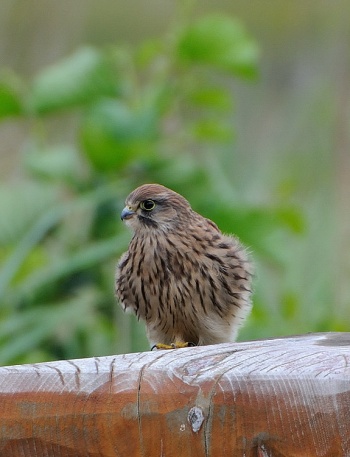Alternative names: Eurasian Kestrel
- Falco tinnunculus
Includes Greater Cape Verde Kestrel; Lesser Cape Verde Kestrel
Identification

Photo © by Alok Tewari
Amboli, Alt. 22-2500 ft., Western Ghats, Dist. Sindhudurg, Maharashtra, India, 8 February 2019
33–39 cm (13-15½ in), wingspan 65-80 cm (25½-31½ in)
- Light chestnut, black spotted upperparts
- Buff, black streaked below
- Black remiges
- Black malar stripe
- Black tipped tail with narrow white rim
- Bright yellow eye ring, cere and feet
- Dark iris, bill and talons
Male: fewer black spots and streaks, blue-grey head and tail
Female: brown tail with black bars
Variations
F.t rupicolaeformis: smaller, darker and more richly-coloured than the nominate
F.t. archeri: is heavily barred
F.t. rufescens: is dark and more chestnut
F.t. canariensis: is small and dark
F.t. dacotiae: pale and heavily-spotted
F.t. neglectus: small and dark
F.t. alexandri: larger and more rufous
Distribution
Europe, Asia and Africa. By far the most numerous falcon in Europe and found from the British Isles and northern Norway south to the Mediterranean and the major Mediterranean islands and from Iberia east to Russia. Also found throughout Turkey and the Middle East, and breeds across Asia to the Pacific coast of the Russian Far East, China, Korea and Japan. In Africa breeds in the north from Morocco to the Nile Valley and south of the Sahara from Senegal east to Ethiopia.
Northernmost populations are migratory, the remainder resident or with the young birds dispersive. Autumn passage extends from August-November and birds return to southern parts of breeding range in February and as late as June in the north. The Common Kestrel is a broad-front migrant but is seen in good numbers along the major migration routes.
Vagrants have been recorded north to Iceland, the Faroes and Svalbard and also south on the Azores. Also recorded in Sumatra and in the Americas in Alaska, Massachusetts, New Jersey and on Martinique.
Taxonomy
Rock Kestrel was formerly included in this species.
Subspecies
About 10 races are recognised[1]:
- F.t. tinnunculus breeds from Europe, northwest Africa, and the Middle East east to east central Siberia, Afghanistan, and western and northern Pakistan east in the Himalayas to Nepal and Bhutan; in winter also to eastern Africa and southern and southeastern Asia
- F.t. perpallidus breeds eastern Siberia (east from the Lena Basin) to Korea and northern China; in winter to eastern China and southeastern Asia
- F.t rupicolaeformis in Egypt and the Middle East
- F.t. interstinctus occurs from the Himalayas to Japan
- F.t. objurgatus in southern India
- F.t. archeri is found on Socotra and in Somalia and coastal north Kenya
- F.t. rufescens in much of mainland Africa
- F.t. canariensis is found on Madeira and the western Canary Islands
- F.t. dacotiae in the eastern Canaries
- F.t. neglectus occurs in the northern Cape Verde Islands
- F.t. alexandri in South East Cape Verde Islands
Habitat
Today a familiar bird along motorway verges and on farmland but also found in a wide range of open habitats. Requires trees, rocks or buildings for nesting and open grassland, heathland or cultivation with an abundant supply of voles and other small rodents.
Behaviour
Flight
Direct flight, rarely interspersed with glides, unlike Eurasian Sparrowhawk. Hovers with still head and fanned tail when hunting.
Diet
The diet includes voles, shrews and mice.
Breeding
The 3-6 brown spotted eggs are incubated by the female for 4 weeks. The young fledge 4-5 weeks later.
Vocalisation
Recording by Alok Tewari
Bairasiul Power Project, Dist. Chamba, Himachal Pradesh, India, March-2013
Call given by an immature, calling first from a perch, and then on taking off.
References
- Clements, J. F., T. S. Schulenberg, M. J. Iliff, S. M. Billerman, T. A. Fredericks, J. A. Gerbracht, D. Lepage, B. L. Sullivan, and C. L. Wood. 2021. The eBird/Clements checklist of Birds of the World: v2021. Downloaded from https://www.birds.cornell.edu/clementschecklist/download/
- Svensson, L, K. Mullarney, D. Zetterstrom (1999) Birds of Britain and Europe. Collins Bird Guide ISBN 0 00 219728
- Global Raptor Information Network. 2019. Species account: Common Kestrel Falco tinnunculus. Downloaded from http://www.globalraptors.org on 30 Mar. 2019.
- Orta, J., Boesman, P. & Marks, J.S. (2019). Common Kestrel (Falco tinnunculus). In: del Hoyo, J., Elliott, A., Sargatal, J., Christie, D.A. & de Juana, E. (eds.). Handbook of the Birds of the World Alive. Lynx Edicions, Barcelona. (retrieved from https://www.hbw.com/node/53213 on 30 March 2019).
Recommended Citation
- BirdForum Opus contributors. (2024) Common Kestrel. In: BirdForum, the forum for wild birds and birding. Retrieved 21 November 2024 from https://www.birdforum.net/opus/Common_Kestrel
External Links
GSearch checked for 2020 platform.








